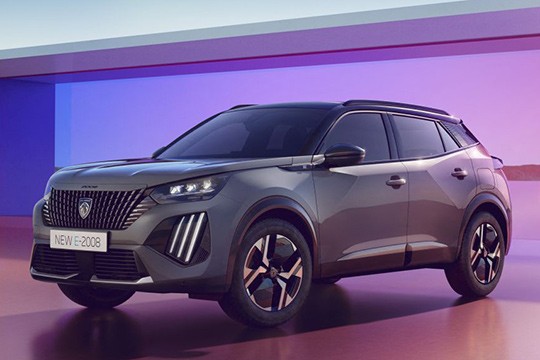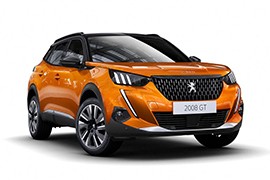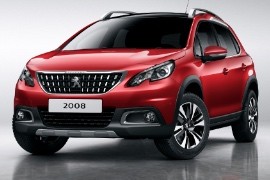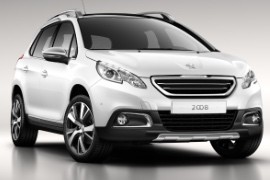PEUGEOT 2008 Models/Series Timeline, Specifications & Photos
First production year: 2013
Engines: Gasoline, Diesel, Electric, Hybrid gasoline
Body style: SUV (Sports Utility Vehicle)
In 2023 Peugeot refreshed the second generation of the 2008 lineup and gave it a more aggressive look, a richer interior, and improved engines.
Many things have changed since 2019, when the second generation of the 2008 broke covers. A world pandemic, an endless microchip crisis, and other unfortunate events shook the automotive market. But, just like during the world financial crisis, carmakers had to do their thing and move on. Peugeot did the same, and despite all odds, it launched the refreshed 2008 lineup in the spring of 2023.
The car's front fascia was adorned with the specific claw design on the bumper, albeit this time, it featured three LED-lit lines instead of one, as on the non-facelifted model. In addition, the grille sported the new badge of the automaker, which was a lion's head. On its profile, the car remained the same, but at the back, there was a new signature lighting, with six horizontal blocks of LEDs instead of three vertical lines as on the 2019 model.
Inside, the standard touchscreen for the infotainment system grew by three inches from seven to ten. This complemented the information received by the driver via Peugeot's i-Cockpit digital instrument cluster. The steering wheel also sported the new badge. Like on its predecessor, customers were greeted by a pair of bolstered front seats up front and a bench seat in the rear for three passengers.
The most significant change for the drivetrain was the electric version, which promised up to 406 km (252 miles) of range from its 156 PS (154 hp) electric motor. Still, for those who needed ICE versions, the automaker offered a range of gasoline and diesel versions.
While the first generation of the 2008 was perceived more or less as a jacked-up 208 SW, the second generation of this moniker came as a fully-fledged independent vehicle that shared nothing with its smaller sibling except for the platform.
Peugeot unveiled the second generation of the 2008 during the world pandemic, and that hurt the car’s sales. Still, the French automaker considered that the market would bounce back and its small-sized crossover would become famous. That happened, indeed, mostly in Europe. Moreover, Peugeot placed its bets on the design and poured a big enough sum to have its artists dream nicer and create a vehicle with a bold look despite its small size.
The second generation of the 2008 came with a front fascia that showed a broad grille with a 3D pattern. It was flanked by the headlights, which were available either with halogen or LED technology. Moreover, vehicles fitted with the newer technology looked even bolder thanks to the extended, vertical DRLs that breached into the lower bumper area, looking like a lion’s fangs. From its profile, the crossover stance was more obvious, and the car didn’t create the same impression of a small-sized station wagon on stilts. To create the idea of higher ground clearance, Peugeot added black plastic cladding on the side sills and chromed trims on the doors, depending on the option. At the back, the automaker took inspiration from the 3008 crossovers when it penned the taillights, which featured three oblique lines.
Inside, the digital instrument cluster was standard for most markets, and drivers could personalize it depending on their moods or tastes. In addition, Peugeot added a touchscreen atop the center stack, in a free-floating position, for the infotainment system. With a dashboard arranged in two levels, the automaker tried to create the image of a taller vehicle, and in a way, it did it. Moreover, Peugeot offered various expensive materials for the 2008’s interior, including carbon fiber trims, leather, and Alcantara. In addition, the contrast stitching was on the list. Besides the front bucket seats, the automaker installed a 40/20/40 split-folding bench seat in the rear, suitable for three passengers but only for short jaunts. Since the vehicle’s width was not that generous, the automaker couldn’t create enough elbow room. Behind them, the trunk featured a completely flat floor.
The 2008 was built on top of the newly developed eCMP platform made by the French automaker. It was used for several models, including for the newly-acquired brands Opel/Vauxhall for the Mokka. This new base allowed the automaker to install internal combustion engines and electric versions. As a result, the 2008 was available with a wide range of gasoline, diesel, or electric motors that sent the power to the front wheels only.
The French automaker Peugeot introduced a facelifted version for its smallest crossover in the family, the 2008.
Since the crossover trend didn't seem to slow down, the French automaker continued the production of the 2008 model. Moreover, it enhanced it based on the feedback received from its customers, and the changes were highly appreciated. While it was not a true off-roader, it offered enough abilities to tackle an unpaved path for a street-oriented vehicle. It was built on the same platform as the small-sized Peugeot 208.
For the facelifted version, Peugeot introduced a new front fascia that put emphasis on the LED headlights. In addition, the front grille featured a 3D pattern where the company's badge took center stage. The lower bumper received a new design that mimicked an underbody aluminum plate. Even though it wasn't made from metal, that plastic shield could protect vital organs from being ripped off by fallen branches. From its profile, the facelifted 2008 revealed its black trims added on the wheel fenders and the higher ground clearance than the regular 208 SW.
Inside, Peugeot offered an option for the i-Cockpit that provided the driver with information about speed, revs, temperatures, and data from the onboard computer. Atop the center stack is a 7" infotainment display with screen-mirroring capabilities. Moreover, the automaker offered an option for a head-up display that significantly improved the driver's comfort. Apart from the front bucket seats, the automaker installed a 60/40 split-folding bench in the back fit for three passengers, although just two could sit comfortably. The trunk space could've been expanded from a decent 410 liters (14.5 cu-ft) to 1,400 liters (49.5 cu-ft).
For off-road driving, the automaker installed a Grip Control system. It worked in conjunction with the ESP to provide maximum traction for the wheels, acting like a limited-slip differential.
Since the customers started asking for more crossovers and SUVs, even automakers with little experience in these types of vehicles found ways to offer something suitable, such as the Peugeot with its 2008.
Peugeot's experience in the SUV segment is minimal. But soon, it discovered that it didn't need that since most European customers bought 2WD crossovers. Thus, the French automaker considered modifying its platforms so it could have something to offer them. And that's how the 2008 came on the market in 2013.
Based on the same platform as the Peugeot 208 SW, the 2008 was more of a regular station wagon with a mild lift kit, and that's where the higher ground clearance came from. In addition, the automaker considered creating a new bodywork. At the front, the feline-like headlights followed the brand's design language, but the large plastic bumper sported a black lower side that was abrasive-resistant. To further emphasize the SUV look, the carmaker added a set of fog lamps inside silver trims, flanking the lower grille. However, from its profile, it mostly resembled a station wagon that was decorated with unpainted rocker panels. At the back, Peugeot installed additional protections under the bumper.
The car's interior was unusually spacious for its segment. Fronting the driver was the same small-sized steering wheel as in the 208 range and a generous instrument cluster. Atop the center stack, Peugeot installed a 7" touchscreen for the infotainment system. The seats, on the other hand, were better than those available in the regular 208 SW, with high-bolstered areas and unique upholstery. At the back, the rear split-folding bench could expand the trunk's volume from a decent 350 liters (12.4 cu-ft) to a respectable 1,194 liters (42.2 cu-ft).



